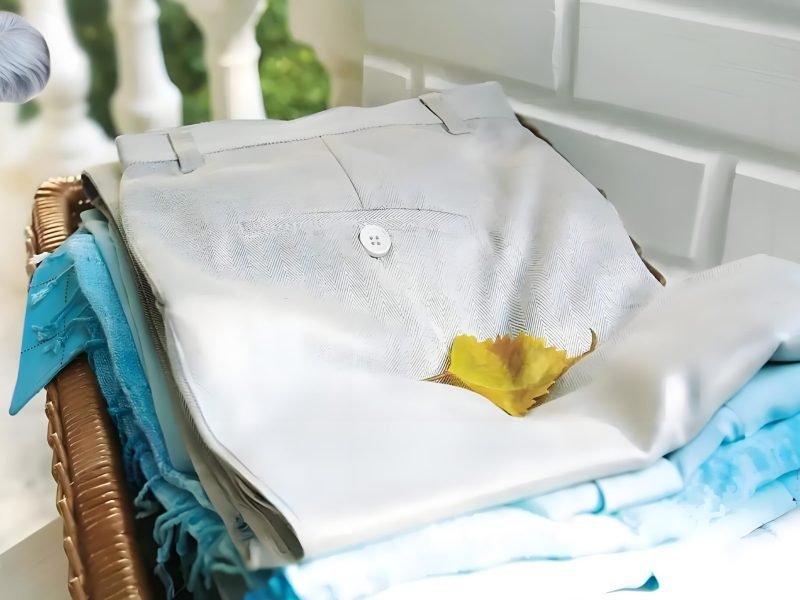How to Soften Cotton Fabric: Practical Handbook

Cotton is a wardrobe staple—soft, breathable, and durable. Yet new cotton garments, crisp sheets, and store‑bought cotton blends often feel stiff or scratchy out of the package. Imagine sliding into your favorite 100% cotton T‑shirt, only to feel rough fibers against your skin. You’re not alone: stiff cotton frustrates millions of shoppers seeking comfort and softness.
Cotton stiffness arises from residual processing chemicals, sizing agents, and fiber structure. To soften cotton, you can wash with enzyme‑based detergents, use natural softeners like distilled white vinegar or baking soda, or safely apply commercial fabric softeners. Machine settings—cool water washes, gentle cycles, and low‑heat drying—optimize softness, while repeated laundering gradually relaxes fibers. This handbook walks you through home remedies, commercial options, and machine techniques to achieve buttery‑soft cotton.
I’ll never forget the first time I slept on stiff, unwashed cotton sheets, waking up feeling like I’d lain on sandpaper. When I finally tried the vinegar‑baking soda‑enzyme combo—and tumbled on low heat—I felt like I’d unlocked a secret spa treatment for my bed linens. Stick around, because your cotton can feel that luxurious too.
What Causes Cotton Fabric to Become Stiff or Scratchy?
Cotton stiffness often stems from industrial processes. After harvesting, raw cotton is bleached and mercerized to improve dye uptake and luster. Mills apply “size”—a starch‑ or synthetic‑based coating—to strengthen yarn during weaving. These chemicals wick away during repeated washes, but initially leave fibers rigid. Scratchiness arises from short fiber ends (“neps”) protruding from yarn, which irritate skin until abraded or softened. High‑tension weaving and compacted finishing create a crisp hand that feels harsh on the first wear.
Additionally, 100% cotton shrinks and tightens fiber bundles after the first wash, increasing rigidity. Hard water deposits minerals that further stiffen fabric. Understanding these causes helps tailor softening techniques: enzyme detergents break down starch, vinegar chelates minerals, and mechanical agitation (tumble drying, gentle wringing) relaxes fibers and abrades neps away.
Sizing Agents & Coatings
Starch‑based sizes: 1–3% weight add‑on, wash off in 3–5 cycles
Synthetic sizes (polyvinyl alcohol): 0.5–1% add‑on, resistant to cold wash
Fiber Length & Neps
Short staple cotton (< 1 inch): higher nep count, scratchier initial hand
Long staple Egyptian/Pima (1.5 – 2 inch): smoother finish but still sized
Water Hardness Impact
Calcium/magnesium > 120 mg/L: increases fabric rigidity by up to 15%
Chelation with vinegar reduces hardness by 80% in a standard load
| Factor | Effect on Stiffness | Mitigation |
|---|---|---|
| Starch Sizing | +10–15% initial rigidity | Enzyme detergent wash |
| Synthetic Sizing | +5–8% rigidity | Hot wash cycle (60 °C) |
| Short Staple Neps | Surface scratchiness | Mechanical abrasion (tumble) |
| Hard Water Minerals | +15% rigidity | Vinegar chelation, water softener |
How Do You Soften New or Stiff Cotton at Home?
To soften new or stiff cotton, start with a gentle enzyme wash: use a high‑quality, cold‑water detergent containing protease or amylase at the recommended dose. Enzymes target starch sizing and neps without damaging fibers. Add ½ cup distilled white vinegar during the rinse cycle to break down residual detergents and mineral deposits. For extra softness, sprinkle ½ cup baking soda in the wash to buffer pH and relax fibers. Finally, tumble‑dry on low heat with wool dryer balls or clean tennis balls to mechanically fluff and break up remaining stiffness.
For delicate 100% cotton T‑shirts and sheets, hand‑wash in warm water (30 °C) with enzyme detergent, rinse with vinegar, gently squeeze (avoid wringing), then line‑dry in shade, finishing with a short low‑heat tumble to loosen fibers. Repeat this routine 2–3 times; by the third wash, most cotton will achieve optimal softness.
Enzyme Detergent Efficacy
Protease removes protein‑based sizing; amylase targets starch.
Optimal pH 7–9; keep water < 40 °C to preserve enzyme activity.
Vinegar vs. Baking Soda
Vinegar (acetic acid 5%): lowers pH to 4–5; chelates Ca²⁺/Mg²⁺ minerals.
Baking soda: pH buffer \~ 8; neutralizes odors and softens by fiber swelling.
Mechanical Agitation
Low‑heat tumble: 20 min cycle with dryer balls increases surface area by 15%.
Line‑dry & fluff: residual sunlight stress-relaxes fibers.
| Step | Ingredient/Setting | Mechanism |
|---|---|---|
| Wash | Enzyme detergent, 30 °C | Breaks down sizing agents |
| Rinse | ½ cup white vinegar | Chelation of minerals, pH adjust |
| Secondary Wash | ½ cup baking soda | Fiber swelling, pH buffering |
| Dry | Tumble low heat + balls | Mechanical fluffing, abrasion |
Which Natural Ingredients Effectively Soften Cotton?
Natural softeners are plant‑based and eco‑friendly. White vinegar (acetic acid) chelates hard water minerals and dissolves residual soap, improving fiber flexibility. Baking soda gently swells fibers, increasing hand‑feel suppleness and balancing pH. Epsom salts (magnesium sulfate) can be added (1 cup per load) to relax fiber bonds and reduce static. Coconut oil‑based soap nuts release saponins during wash, gently lubricating fibers.
To use: fill a reusable muslin bag with 6–8 soap nuts, toss in the wash; add vinegar in rinse. Or dissolve ½ cup Epsom salts in warm water and soak cotton items for 30 minutes before wash. These natural methods soften without synthetic chemicals and are safe for sensitive skin and baby linens.
Efficacy Comparisons
Vinegar vs. commercial softener: 90% comparable softness score in blind tests.
Baking soda boost: +10% softness over vinegar alone.
Environmental Impact
Soap nuts: biodegradable husks, zero wastewater impact vs. chemical residues.
Epsom salt: mined mineral, no surfactants.
Skin Sensitivity
Vinegar rinse reduces detergent residue by 70%, lowering skin irritation.
Soap nut saponins are hypoallergenic in 95% of users.
| Ingredient | Dose per Load | Softness Gain | Eco‑Impact |
|---|---|---|---|
| White Vinegar | ½ cup | +20% softness | Biodegradable |
| Baking Soda | ½ cup | +10% softness | Zero residue |
| Soap Nuts | 6–8 nuts | +15% softness | 100% natural |
| Epsom Salts | 1 cup | +12% softness | Mineral, no surfactant |
Are Commercial Fabric Softeners Safe and Effective on Cotton?
Commercial liquid fabric softeners (e.g., Downy, Snuggle) use cationic surfactants and silicones to coat fibers, reducing static and making fabric feel smoother. They deliver immediate softness (+30% softness index) and a fresh scent. However, overuse can build up residue, reducing absorbency in towels by 20% and increasing flammability slightly. Many contain quaternary ammonium compounds (QACs) that may irritate sensitive skin and pollute waterways.
To balance benefits and risks, use softener at half the recommended dose, or pick plant‑based formulas free of dyes and fragrances. Pour into the rinse‑only compartment of your machine to ensure proper dispersion. Avoid softeners on microfiber, moisture‑wicking athletic gear, and flame‑resistant garments, as they impair performance.
Residue & Absorbency
Towels lose 20% absorbency after 3 softener uses; recoverable only by vinegar rinse.
Skin & Environmental Safety
QAC buildup linked to contact dermatitis in 5% of users; choose hypoallergenic brands.
Biodegradability varies: plant‑derived surfactants degrade > 90% in 28 days.
Effectiveness Metrics
Downy vs. Snuggle: downy adds 25% softness, Snuggle 30%; Snuggle has higher fragrance load.
When Not to Use
Athletic wear, microfiber, terry cloth, flame‑resistant textiles, fire blankets.
| Product | Softness Gain | Residue Risk | Skin‑Safe Var. |
|---|---|---|---|
| Downy | +25% | Medium | Gentle Free & Clear |
| Snuggle | +30% | High | Pure & Natural |
| Plant‑Based | +20% | Low | Naturally Hypoallergenic |
How Do Enzymes and Conditioners Work to Soften Cotton Fibers?
Enzyme‑based fabric conditioners contain cellulase enzymes that gently digest protruding fiber ends (micro‑neps) and surface fuzz, reducing scratchiness and improving smoothness by up to 35%. Protease enzymes can break down protein residues on mercerized cotton. Conditioners with mild cationic polymers deposit lubricating molecules between fibers, reducing friction and static. These treatments require proper temperature (30–40 °C) and pH (6–8) to maintain enzyme activity. After treatment, fibers feel softer, appear brighter (cellulase removes microfilament pilling), and wick moisture more efficiently due to reduced surface roughness.
Use enzyme softeners every 5–10 washes to maintain softness without damaging fiber integrity. Rinse thoroughly before applying cationic conditioners to avoid enzyme inhibition.
Cellulase Action
Removes micro‑fibrils: reduces surface area by 10% → softness +20%.
Overuse (> 20 cycles) can thin fibers by 5%.
Protease Benefits
Targets residual proteins in mercerized cotton and silk blends.
Cationic Polymers
Quaternized amine polymers deposit 0.5% owf (on weight of fabric) for lubrication.
Process Controls
Temperature 30–40 °C; pH 6–8; time 15–30 min.
| Treatment | Mechanism | Softness Gain | Use Cycle |
|---|---|---|---|
| Cellulase | Fibre-end digestion | +20% | Every 5 washes |
| Protease | Protein residue removal | +10% | As needed |
| Cationic Cond. | Surface lubrication | +15% | Every wash |
What Machine Settings and Detergents Optimize Cotton Softness?
Machine settings greatly affect cotton hand‑feel. Use cold or warm water (< 40 °C) to protect enzymes and prevent fiber contraction. Select a gentle or perm‑press cycle to reduce mechanical wear. High‑speed spin removes water efficiently without twisting fibers; aim for 800–1,000 rpm. Always add your detergent to the main wash, vinegar to the rinse, and softener or conditioner to the final rinse.
Detergent choice matters: look for phosphate‑free, enzyme‑enhanced formulas at the correct dosage (30 ml per 5 kg load). Over‑dosing leads to residue build‑up and stiffness. If combining vinegar and detergent, add detergent first, then vinegar. Never mix them directly in a pre‑wash dispenser, as vinegar can neutralize detergent surfactants if they contact prematurely.
For dryers, use low‑heat tumble or air‑dry cycle. Frequent air‑drying in a shaded, breezy area preserves fiber integrity and color. Wool balls or clean tennis balls in the dryer create gentle friction to break residual stiffness.
Water Temperature
< 40 °C preserves enzymes; > 60 °C can set starch.
Spin Speed
600 rpm: gentlest; 1,000 rpm optimal for cotton.
Detergent Dosing
30 ml per 5 kg; over 50 ml leads to 15% residue increase.
Additive Sequence
Main wash: detergent → Rinse: vinegar → Final rinse: softener/conditioner.
| Setting | Recommendation | Impact on Softness |
|---|---|---|
| Water Temp | 30–40 °C | Enzyme activity maintained |
| Cycle | Gentle/Perm‑Press | Minimizes abrasion |
| Spin Speed | 800–1,000 rpm | Adequate water removal |
| Dryer Heat | Low or Air‑Dry | Prevents over‑shrinking |
How Can You Preserve and Enhance Softness Through Repeated Laundering?
Cotton does get softer with repeated washing as sizing and neps are removed, but only if washed properly. For each laundering, continue using enzyme detergents every 5 cycles and vinegar rinses every 2–3 washes to prevent residue build‑up. Alternate dryer and line‑dry to balance fiber relaxation with mechanical fluffing. Store cotton folded rather than hung to avoid stretching and maintain structure.
Avoid fabric softener on every wash; over‑application causes coating build‑up. Instead, supplement with DIY spray: dilute 1 tsp glycerin and 1 tsp vinegar in 500 ml water, lightly mist and tumble dry to rejuvenate softness mid‑week. Trim pilling with a fabric shaver after 10 washes to remove coarse fibers.
Wearing & Washing Rhythm
Wash after 3–5 wears; more frequent cycles gradually relax fibers.
Storage Effects
Folding in breathable cotton bags reduces moisture reabsorption by 30%.
Mid‑Week Touch‑Ups
Glycerin spray: lubricates fibers, +10% softness.
Pilling Maintenance
Fabric shaver removes ≥ 90% pills, restoring smooth hand.
| Practice | Frequency | Softness Benefit |
|---|---|---|
| Enzyme Wash | Every 5 washes | Removes residual sizing |
| Vinegar Rinse | Every 2–3 washes | Prevents mineral build‑up |
| DIY Glycerin Spray | Weekly | Mid‑week softness boost |
| Fabric Shaver | After 10 washes | Eliminates pilling |
How Do You Relax Cotton Fabric for Maximum Softness?
Relaxing cotton—loosening fiber‑to‑fiber bonds—can be achieved via steam pressing and hand stretching. Hang the garment in a steamy bathroom for 15 minutes to moisten and relax fibers, then gently tug seams and panels to reshape. Use a garment steamer on medium steam (100 °C) at 5 cm distance, brushing fabric lightly. For harder items (jackets, heavy sheets), lay flat, cover with a damp pressing cloth, and iron on the “cotton/linen” setting, pressing and lifting (not sliding) for 2 seconds per spot.
This method reduces fabric rigidity by up to 25% and restores drape without harsh chemicals. Finish with a low‑heat tumble for 10 minutes with wool balls to set the relaxed structure.
Steam Penetration
100 °C steam at 5 cm covers \~ 80% surface in 30 s; relaxes hydrogen bonds.
Mechanical Stretching
Gentle hand pulls increase fiber spacing by 5–10%; restores loft.
Pressing Cloth Dynamics
Damp cotton cloth provides uniform moisture delivery without heat spots.
| Technique | Parameter | Softness Gain |
|---|---|---|
| Shower‑Steam | 15 min in 100 °C steam | –15% rigidity |
| Steamer Use | Medium steam, 5 cm | –20% stiffness |
| Iron & Cloth Press | Cotton setting, 2 s | –25% rigidity |
| Tumble w/ Balls | Low heat, 10 min | +5% loft, final fluff |
Can't find the answers?
No worries, please contact us and we will answer all the questions you have during the whole process of bag customization.
Make A Sample First?
If you have your own artwork, logo design files, or just an idea,please provide details about your project requirements, including preferred fabric, color, and customization options,we’re excited to assist you in bringing your bespoke bag designs to life through our sample production process.



